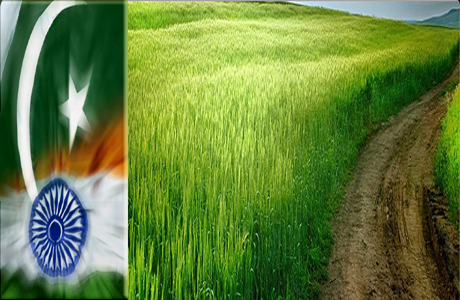Agriculture subsidies: Pakistan
versus India
By BR Research
 Pakistan
is currently contemplating to grant non-discriminatory
nation status (equivalent to MFN status) to India in its
bilateral trade.
Pakistan
is currently contemplating to grant non-discriminatory
nation status (equivalent to MFN status) to India in its
bilateral trade.
It is hoped that
reciprocal gestures by India will lead to the shortening of
its SAFTA Sensitive List and give access to Pakistani
agricultural and textile products.
While simultaneously
relaxing its non-tariff barriers that are applied more
strictly on imports from Pakistan.
Presently, Pakistan
maintains a Negative List with respect to imports from
India.
This list includes 1,209
tariff lines. Despite this restriction, Indian exports to
Pakistan were $2.06 billion compared to only $542 million
exported by Pakistan to India in FY13.
Therefore, India enjoys a
large trade surplus of $1.52 billion with respect to
Pakistan.
Major Indian exports to Pakistan include cotton, oil cakes,
vegetables, synthetic yarn, fabrics and chemicals. The share
of agricultural exports to Pakistan was 55 percent.
There have also been years
like FY11 when Pakistan imported $337 million worth of sugar
from India. On the other hand, Pakistan's major exports to
India in FY13 included minerals, dates, cement, chemicals
and petroleum products.
The share of agricultural
items to India was only 21 percent.
There has been a dramatic
reversal in the pattern of trade between India and Pakistan.
At the time of partition, Pakistans exports to India
primarily comprised of agricultural products like cotton and
wheat.
Now, India is the major
exporter of Pakistan of agricultural commodities like
cotton, vegetables, sugar, animal and poultry feed, etc.
What explains the fundamental change in relative comparative
advantage in agriculture between the two countries? The view
strongly put forward by the Farmers Associations of Pakistan
is that this is primarily due to two factors.
First, India subsidizes its agriculture much more than
Pakistan, thereby making it artificially competitive.
Second, Pakistan provides little or no protection to its
farmers though import tariffs.
Lets examine the validity of
these two explanations below.
On the subsidy issue, the latest information, as of FY12, is
that India subsidised fertiliser use (all types) to the tune
of $15,171 million.
Other subsidies went to
irrigation ($6,303 million), electricity consumption by
farmers ($7,326 million) and to other inputs like seed,
tractors, crop insurance, etc ($8,832 million).
The total agricultural
subsidy bill for India in FY12 is estimated at $37,362
million, equivalent to 2.2 percent of the GDP.
The corresponding estimates for subsidies in Pakistan in
FY12 are $356 million on fertiliser (net of the GST on the
input). Other subsidies are for irrigation ($193 million),
electricity and others ($342 million).
The total subsidy aggregates
to $897 million, which is 0.4 percent of the GDP. Therefore,
controlling for the size of the economy, Indian subsidies to
agriculture are over five times as much as of Pakistan.
Consequently, yields are
somewhat higher by 10 to 27 percent in many crops.
The second explanation is also valid. Pakistans imports of
cotton, tomatoes and onions are all importable duty free
from any source, including India. This is primarily due to
strong trading and industrial lobbies in the country.
The cost of production of
different crops in India is about 10 to 15 percent lower on
average than in Pakistan; mainly due to substantially larger
subsidies.
Clearly, if a level playing field is to be provided to
Pakistani farmers, then there is a strong case for
introduction of a minimum MFN duty on agricultural products
of 10 to 15 percent.
In addition, Pakistan must emphasise to India that the trade
imbalance has been magnified by the fact that many of its
potential exports to India, of agricultural products and
textiles especially, are in Indias Sensitive List of SAFTA.
Also, both countries must
ensure that all non-tariff barriers are not applied in a
discriminatory manner towards each other.
March, 2014
Source:
Business Recorder